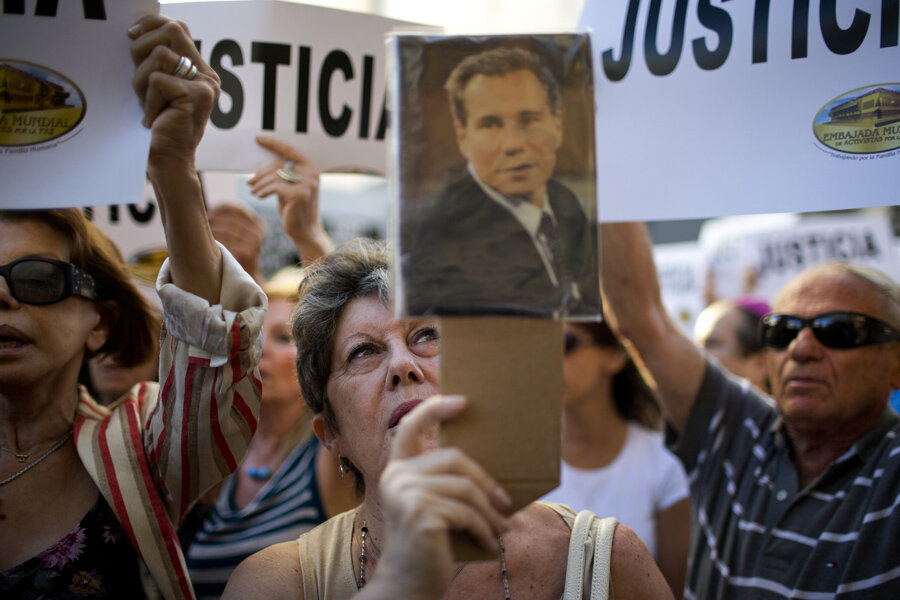Death of Argentine prosecutor - what we know and don't know
Loading...
"Yo soy Nisman," read the protesters' signs, an echo of the French slogans after the terrorist attack on Charlie Hebdo in Paris.
What could lead suspicious Argentines to connect the death of federal prosecutor Alberto Nisman, quickly ruled a suicide by police, with notorious killings half a world away? Quite a lot, as it happens.
Mr. Nisman had been obsessively on the trail of the perpetrators of the July 1994 bombing of a Jewish community center in Buenos Aires for the past decade. He was tasked with the investigation by Nestor Kirchner, the former president and deceased husband of President Cristina Fernandez de Kirchner. Nisman died at home on Sunday night, shortly before he was to expound publicly on a political bombshell he laid on Argentina's public earlier this month, namely that President Kirchner had promised to cover up Iran's involvement in the 1994 terrorist attack, the worst in Argentina's history, in which 85 people died.
The truth? Not yet clear. But the death of a polarizing prosecutor at such a juncture is likely to roil Argentine politics for some time to come. What's known about his death and his investigation so far? And what are the key unanswered questions?
The 1994 bombing investigation
Argentina is home to the largest Jewish community in Latin America, about 200,000 people. The 1994 bombing of the community center followed a 1992 attack on the Israeli Embassy there that left 29 dead. That bombing, too, remains unsolved. Suspicion in both attacks quickly fell on Hezbollah, the militant Lebanese Shiite movement that has close ties to Tehran. Many were convinced that Iran must have also played a direct role.
But Argentina's investigation into both cases was plagued by both corruption and incompetence.
Judge Juan José Galeano was originally in charge, but his prosecution went awry after it was found he'd paid a witness $400,000 to lie and claim Argentine police officers were involved in providing logistical support for the attack. After he was removed from the judiciary, Mr. Nisman took over in 2005.
By 2006, he was claiming that senior Iranian officials were involved in the attack, including the country's former President Ali Akbar Hashemi Rafsanjani. His key witness? Abolghasem Mesbahi, an alleged former Iranian intelligence officer, who has made a career of leveling accusations against Iran since his defection in 1996. He claimed that former President Carlos Menem was paid about $10 million to hide Iran's involvement.
Mr. Mesbahi has also insisted that Iran was behind the 1988 bombing of Pan Am Flight 103 over Lockerbie in Scotland, instead of Muammar Qaddafi's Libya. A Libyan intelligence agent was ultimately found guilty of murder by a special tribunal; Mr. Qaddafi's regime paid substantial reparations over the attack.
Nisman's allegations against Kirchner
Before his death, Nisman filed a 289-page complaint that contains what he said were transcripts of intercepted phone calls – presumably by Argentine intelligence – between Iranian and Argentine officials. The officials allegedly discussed a deal in which Iranian oil would be provided to Argentina in exchange for killing the probe into Iranian links to the 1994 bombing.
Nisman's filing, which a judge made public on Wednesday, three days after the prosecutor's death, says the deal never came to fruition because Argentina couldn't deliver on its side of the bargain, namely convincing Interpol to revoke arrest warrants issued for Iranian officials wanted for questioning in Argentina. Nisman went public with these accusations last week.
Are the transcripts genuine? Impossible to say. Nisman insisted that they were, but Kirchner and her allies have been scathing about them, saying they were fabricated by Antonio "Jaime" Stiusso, a veteran counterintelligence officer and wiretapping expert. Mr. Stiusso had worked closely with Nisman since 2005. Last month he was fired by Kirchner in a reshuffle of intelligence officials that observers said was an effort to create a service more directly loyal to her. Argentina's government-run news service Telam writes that Nisman's claims were a "maze filled with inconsistencies."
What is clear is that between 2011 and 2013 Argentina tried to work out some kind of oil-for-food deal with Iran, and that in 2013 Kirchner's government reached an agreement with Iran to conduct a joint inquiry into the 1994 attack, though that agreement was declared unconstitutional by an Argentine court in 2014.
One question is why an ally of Kirchner, or someone else, would kill Nisman when his evidence was already a matter of record?
Details of Nisman's death
Nisman was found in his bathroom on Sunday night, with a .22 caliber gun next to him and dead from a head wound. Early reports said the main police theory was suicide and that his apartment was securely locked. On Wednesday, the Associated Press reported that a locksmith had found breaking into the home would have been easy via a back door and that police had also found a crawl way connected to a neighboring apartment.
Lead prosecutor Viviana Fein said there was no evidence of anyone else involved in the death, but said Nisman left no suicide note. A test of his hand showed no residue of gunpowder, though she said that may have been due to the small caliber of the gun. The fact that national Security Secretary Sergio Berni quickly turned up in the apartment also fed doubts.
Fein said the gun found beside Nisman was registered to another man, Diego Lagomarsino, described by officials as a colleague of Nisman, who reportedly gave it to him on Saturday.








